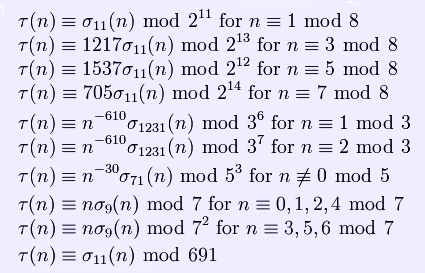| == |
The Ramanujan tau function is the function
The first few values of the tau function are given in the following table (sequence A000594 in OEIS):
If one substitutes q = exp(2πiz) with
is a holomorphic cusp form of weight 12 and level 1, known as the discriminant modular form. Ramanujan observed, but could not prove, the following three properties of τ(n): * τ(mn) = τ(m)τ(n) if gcd(m,n) = 1 (meaning that τ(n) is a multiplicative function) * τ(pr + 1) = τ(p)τ(pr) − p11τ(pr − 1) for p prime and * The first two properties were proved by Mordell in 1917 and the third one was proved by Deligne in 1974. Congruences for the tau function For
For
Retrieved from "http://en.wikipedia.org/"
 |
|

